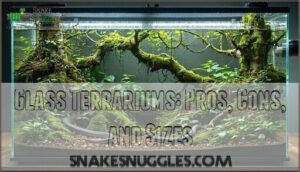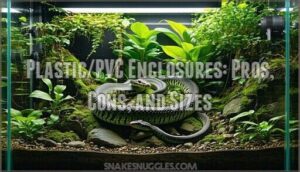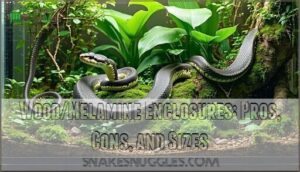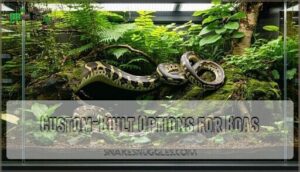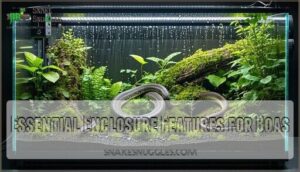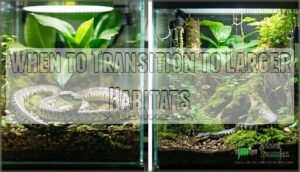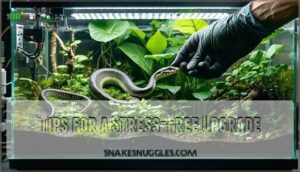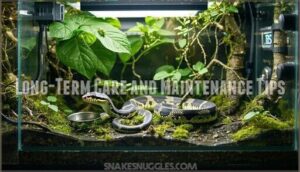This site is supported by our readers. We may earn a commission, at no cost to you, if you purchase through links.
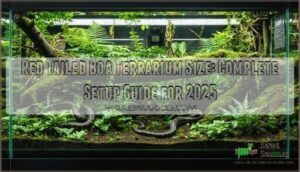 You’ll need a minimum 6′ x 3′ x 3′ terrarium for an adult red-tailed boa, though larger specimens require 8′ x 4′ x 4′ enclosures. Start babies in 20-gallon tanks and upgrade as they grow. Your boa should be able to stretch its full length comfortably – think of it as giving them enough room to really spread out.
You’ll need a minimum 6′ x 3′ x 3′ terrarium for an adult red-tailed boa, though larger specimens require 8′ x 4′ x 4′ enclosures. Start babies in 20-gallon tanks and upgrade as they grow. Your boa should be able to stretch its full length comfortably – think of it as giving them enough room to really spread out.
Veterinary studies confirm that proper enclosure sizing reduces stress and promotes natural behaviors. Plan upgrades when your snake reaches two-thirds of the current enclosure’s length.
The right terrarium dimensions form the foundation of successful boa care, but material choice matters just as much.
Table Of Contents
Key Takeaways
- You’ll need to upgrade enclosures multiple times as your boa grows – start with a 20-gallon tank for babies and progress to a minimum 6′ x 3′ x 3′ terrarium for adults over six feet long.
- Your adult red-tailed boa must be able to stretch its full length comfortably, so measure your snake first and ensure the enclosure allows complete body extension to prevent muscle problems.
- Choose your enclosure material wisely – PVC offers better heat retention and humidity control than glass, while wood provides excellent insulation but requires careful moisture management.
- You’ll need proper security features like sturdy lid clamps, a thermal gradient with basking spots at 85-92°F, and substrate depth of at least 3 inches to maintain 60-80% humidity levels.
Red Tailed Boa Terrarium Size Guide
You’ll need to match your red tailed boa’s enclosure to their size, starting with a 20-gallon tank for babies and scaling up to a minimum 6′ x 3′ x 3′ terrarium for adults over six feet long.
Your boa needs room to stretch out completely and move around naturally, which keeps them less stressed and more active according to veterinary research.
Minimum Size Requirements by Age
Your boa constrictor needs different enclosure dimensions as it grows. Baby boa size requirements start at 2’L x 1.5’W x 1’H for neonates under two feet. Juvenile boa needs increase to 4’L x 2’W x 2’H for snakes between 2-5 feet. Adult boa space expands to 6’L x 3’W x 3’H minimum, while large boa housing requires 8’L x 4’W x 4’H for specimens over eight feet. These stretching requirements guarantee proper development.
It’s also important to keep in mind terrarium temperature requirements to guarantee the boa’s health.
Recommended Dimensions for Adults
Most adult boa constrictors need substantial floor space when planning your setup. Standard adult enclosure dimensions should measure 6’L x 3’W x 3’H, though larger specimens exceeding 8 feet require 8’L x 4’W x 4’H enclosures.
Consider these key factors for adult boa housing:
- Snake size determines enclosure size – measure your boa’s adult length first
- Enclosure height needs allow for climbing branches and vertical movement
- Multiple boa housing requires much larger dimensions per animal
- Enrichment considerations demand extra space for hides, water bowls, and décor
Importance of Full-Length Stretching
Red-tailed boas need enough room to stretch their entire body length to stay healthy. When they can’t fully extend, these snakes develop muscle weakness and joint stiffness that hurts their quality of life.
Red-tailed boas confined to cramped spaces develop muscle weakness and joint problems that compromise their long-term health
Tight spaces that limit movement hurt their physical health. That’s why getting the enclosure size right matters so much for proper red-tailed boa care.
Choosing The Right Enclosure Type
You’ll need to choose between glass, plastic/PVC, and wood enclosure materials, each offering distinct advantages for maintaining your boa’s environmental needs.
Glass terrariums provide excellent visibility and durability but can be heavy and expensive, while plastic/PVC enclosures excel at retaining heat and humidity more efficiently than traditional materials.
Glass Terrariums: Pros, Cons, and Sizes
Glass enclosures offer excellent visibility for monitoring your red-tailed boa’s health and behavior. However, weight concerns make cleaning challenging, and breakage risks require careful handling. Cost analysis shows larger glass terrariums become expensive quickly.
Heat retention proves difficult with screen tops, demanding supplemental heating. Glass enclosures struggle maintaining ideal humidity levels. Minimum dimensions for boa constrictor enclosure size remain 6’x2’x2′ for adults.
For the first few months, a minimalist terrarium is recommended to facilitate quarantine.
Plastic/PVC Enclosures: Pros, Cons, and Sizes
PVC enclosures excel in boa constrictor housing through enhanced heat retention and moisture resistance. These lightweight alternatives to glass offer excellent PVC durability while maintaining stable humidity levels essential for red-tailed boa health.
Cost analysis reveals a higher upfront investment, but customization options and easy maintenance justify the expense. Weight considerations favor PVC over heavier materials, though large adult enclosures require significant space planning for best functionality.
Wood/Melamine Enclosures: Pros, Cons, and Sizes
Wood durability makes these enclosures ideal for Red Tail Boas requiring long-term housing. Building boa constrictor enclosures from wood provides excellent insulation but creates humidity concerns in high-moisture environments.
Melamine offers cost-effective DIY enclosures, though melamine toxicity concerns arise if damaged surfaces aren’t sealed properly.
Cost analysis favors wood over glass for large snake enclosure dimensions.
Custom-Built Options for Boas
Building boa constrictor enclosures yourself opens unique dimensions beyond commercial cages. DIY enclosures using PVC or sealed plywood accommodate large adult Red Tailed Boa housing needs perfectly.
Professional builders offer expandable, stackable designs with integrated features. Material choices include moisture-resistant PVC panels and aluminum frameworks.
Cost analysis shows custom builds range from $500-$2000+, depending on complexity and securing snake enclosures requirements.
Essential Enclosure Features for Boas
You’ll need three critical features to create a proper boa enclosure: secure locks to prevent escapes, a thermal gradient with basking spots at 85-92°F and cool zones at 75-80°F, and proper substrate with humidity levels maintained between 60-80%.
Getting these basics right means your boa can thrive in conditions that mirror its natural habitat requirements and support long-term health.
Security and Escape Prevention
Red-tailed boas are notorious escape artists, making proper securing of snake enclosures absolutely critical. Install sturdy lid clamps on glass terrariums and reliable locking mechanisms on front-opening enclosures.
Secure ventilation areas with fine mesh to prevent escapes while maintaining airflow. DIY solutions like additional latches provide extra security. Never use tape for escape prevention—it’s dangerous and ineffective.
Heating, Lighting, and Temperature Control
Getting your enclosure locked down is just the first step—your red tailed boa needs the right thermal setup to stay healthy. You’ll want basking spots hitting 86–90°F while keeping cool zones around 75–80°F. At night, let temperatures drop to 68–75°F so your snake can follow its natural rhythm.
- Overhead ceramic heat emitters work best, but always pair them with a reliable thermostat
- Digital thermometers on both ends give you the real picture of what’s happening
- A 12-hour light cycle with UVB helps reduce stress and keeps behavior patterns normal
Substrate and Humidity Needs
Getting your red tailed boa’s home right means picking the right bedding and keeping things humid enough. You’ll want at least 3 inches of substrate so your snake can burrow and the enclosure holds moisture well.
Forest Floor cypress mulch does a great job here – it helps you track humidity levels and keeps mold at bay.
Snake substrate should never include cedar or pine, which contain toxic oils.
| Substrate Variety | Humidity Range | Shedding Success Tips |
|---|---|---|
| Cypress mulch | 60-80% | Increase to 85% during shed |
| Coconut fiber | 65-75% | Add humid hide with moss |
| Bioactive mix | 70-80% | Monitor with digital hygrometer |
Upgrading Enclosures as Boas Grow
You’ll need to upgrade your boa’s enclosure multiple times throughout its life, starting from a 20-gallon tank for juveniles and progressing to a minimum 6’L x 3’W x 3’H setup for adults.
Plan these transitions based on your snake’s growth rate, generally moving to larger housing when your boa reaches two-thirds of its current enclosure’s length.
When to Transition to Larger Habitats
Your red tailed boa’s growth milestones signal when upgrades become necessary. Juveniles outgrow their terrarium when they can’t fully stretch out, usually every 12-18 months.
Adults showing increased activity levels or difficulty getting around their snake habitat requirements need more space.
Monitor shedding frequency and feeding habits – cramped conditions affect both. Watch how your boa uses available space for accurate timing.
Tips for a Stress-Free Upgrade
Moving your Red Tail Boa to a larger habitat doesn’t have to stress either of you out. Like any big change, timing and technique matter most for successful Red Tailed Boa husbandry.
- Plan upgrade timing around your snake’s natural rhythm – avoid shedding periods and feeding days
- Use proper handling techniques with confident, steady movements to transfer juveniles and adults safely
- Allow gradual acclimation by placing familiar hides and water bowls in the new snake habitat requirements setup
- Monitor behavior closely for the first week, watching for feeding response and normal activity patterns
Long-Term Care and Maintenance Tips
You’ll need to maintain your boa’s terrarium environment through regular cleaning, consistent temperature monitoring at 80-85°F, and proper feeding schedules with appropriately sized frozen-thawed rodents.
Getting these basics right from day one stops problems before they start and keeps your boa healthy in a properly sized home for years to come.
Cleaning and Sanitizing The Terrarium
Weekly spot cleaning keeps your boa’s home healthy. Remove waste immediately using disinfecting solutions like Quat Plus for thorough cage cleaning. Replace soiled substrate sections and scrub water bowls with hot, soapy water twice weekly.
Monthly deep cleans involve removing everything, washing surfaces with waterproof sealant-safe cleaners, and replacing all substrate. These preventative measures guarantee proper snake care and cage maintenance.
Monitoring Environmental Conditions
Track your boa’s environment with dual thermometers placed at both ends of the temperature gradient. Proper thermometer placement ensures accurate thermoregulation monitoring throughout your boa’s thermal gradient.
Digital hygrometers need monthly calibration using the salt test method. Monitor humidity levels between 60-75%, adjusting for seasonal changes when heating systems alter indoor air moisture.
Feeding and Hydration Guidelines
Proper nutrition forms the foundation of boa health. Feed adults one appropriately-sized rat weekly, ensuring prey size matches your snake’s thickest body part. Frozen rodents prove safer than live options, eliminating injury risk.
Provide fresh water in sturdy bowls, replacing every few days. Monitor feeding frequency closely—juveniles need meals every 5-7 days while adults thrive on 10-14 day schedules.
Frequently Asked Questions (FAQs)
How often should I clean the terrarium for my red tailed boa?
Keep fresh substrate in your terrarium and clean up waste right away. Change out all the substrate every 4-6 weeks to maintain a healthy environment.
Clean water bowls weekly, and disinfect the entire enclosure monthly for best health.
Whats the minimum ceiling height for climbing branches?
You’ll need at least 24-30 inches of ceiling height for climbing branches, ensuring your boa can stretch vertically and access elevated perches safely without touching the top.
How much does a proper adult terrarium cost?
Expect to spend $200-600 for a quality adult terrarium. Glass tanks run $300-500, while PVC enclosures cost $200- You’ll need heating equipment, substrate, and accessories adding another $100-200 total.
Are there any legal size requirements by state?
No specific state laws require minimum terrarium sizes for red-tailed boas. States regulate whether you can own them and transport requirements, but enclosure dimensions remain unregulated federally or state-wide.
Conclusion
Picture your red-tailed boa cramped in a shoebox-sized enclosure, desperately attempting pirouettes that would make a contortionist weep. Getting the recommended terrarium size for a red-tailed boa right prevents this tragic comedy.
Your adult boa needs that 6′ x 3′ x 3′ minimum space to thrive, not just survive. Remember, proper sizing reduces stress, promotes natural behaviors, and keeps your scaly friend healthy.
When you provide adequate space, you’re investing in years of successful snake keeping and watching your boa display its full range of natural behaviors.
- https://www.bigappleherp.com/pages/care-sheet-for-red-tail-boas
- https://zoomed.com/red-tailed-boa/
- https://www.nwzoo.com/pdf/NWZoo_Boa_Constrictor_Care.pdf
- https://www.thebiodude.com/blogs/snake-caresheets/boa-constrictor-care-guide-and-bioactive-terrarium-maintenance
- https://reptifiles.com/boa-constrictor-care/boa-constrictor-temperatures/

